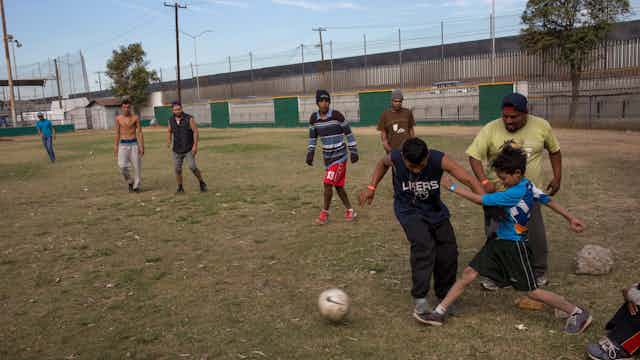When a woman I’ll call Elisa and her 15-year-old daughter, Ana, journeyed from their home in Honduras to Tijuana, Mexico, they survived due to the generosity of a friend who gave them bus tickets, strangers they met aboard the bus headed north and a temporary Mexican humanitarian visa.
Once they arrived, they stayed in a shelter at a local church whose congregation provided food, toiletries and free health care. Elisa also helped others, by cooking, cleaning the shelter’s common areas and caring for another sick resident.
As a nonprofit leader, I have built partnerships between U.S. charitable groups and those in Spanish-speaking communities. Now I’m conducting research on how immigrants rely heavily on informal and voluntary support on both sides of the U.S.-Mexico border. Whether migrants arrive in large groups or on their own, I believe this largely unseen generosity is keeping many of them from going hungry and homeless and enhancing their personal safety in precarious conditions.
This informal giving supplements the insufficient aid available through more official channels.
No official safety net
Asylum seekers may not earn a living in the U.S. or even apply for permission to work while they wait for their claims to be considered.
They are also ineligible for safety net programs like the Supplemental Nutrition Assistance Program and housing vouchers that would help them get food and shelter.
That means the approximately 319,000 people with pending asylum cases are left to fend for themselves after they enter the U.S. if they are not being detained in federal facilities or government-funded shelters. They also get either scant support or no help at all from the Mexican government before they enter the U.S. – although with a humanitarian visa, they can apply to work temporarily.
So how do they survive?
In Tijuana they can stay in places like the Benito Juarez Sports Complex.
Others get luckier and find beds in shelters, such as Camino de Salvación, where about 45 Central American migrants can stay at a time. In the U.S., there are some shelters as well, such as those run by groups like Jewish Family Services in San Diego and Casa Marianella in Austin, Texas.
A patchwork of immigrant-serving organizations, primarily U.S.-based, received US$516 million in 2017 and 2018 from private sources, according to the Foundation Center – a nonprofit that gathers and analyzes philanthropy data. Some 2,075 grantmakers distributed these funds to 2,664 organizations.
A new wave
Central Americans have sought asylum in the U.S. for decades.
A prior wave, which included millions of people from Honduras, El Salvador, Nicaragua and Guatemala who were fleeing violence, began in the 1980s. It began to recede after 1990, when 122,000 refugees arrived from across the world.
By 2016, the number of annual asylum seekers had risen again to 86,000. The U.S. granted 20,455 of their asylum claims that year, including 6,530 from Central America and Mexico.
Groups in Mexico and the U.S. have responded to this wave of asylum-seeking in a variety of ways. Some have created new and larger shelters. Others have established an informal network of individual homes where asylum-seekers may stay. It serves as a modern-day underground railroad.
Filling gaps
These informal networks exist far from the political spotlight and often don’t involve any money changing hands. They are even outside the constellation of immigration nonprofits and advocacy groups.
In many cases, I have seen migrants themselves give what they can to others in the same predicament. That may sound surprising, but research supports a tendency I’ve personally observed: Low-income people can be quite charitable despite their circumstances.
For example, the global philanthropy scholar Pamala Wiepking has found that the poor give away a larger share of their income than the rich.
Once they become more established, immigrants keep expressing their concern for others through the donations they give directly, such as by wiring their own money abroad to loved ones who stayed behind, or by supporting a cause without giving money to nonprofits involved in it.
The migrants I observed and interviewed shared meals. They helped one another find rides and navigate the bus system, look for work, and care for children and the sick. In a place like Camino de Salvación, where everyone is enduring high levels of stress and most have personally experienced trauma, simply engaging in conversation and offering moral support can serve as valuable gifts.
Taken together, these different sources of support, both formal and informal, are giving some of the thousands of Central American migrants who head north a little breathing room.
When I visited the Camino de Salvación shelter, Ana, the teen, wasn’t eager to talk to strangers about her experience. Elisa told me she barely left her room and avoided any conversation about the troublesome days in Honduras before they left.
Elisa spent the days preparing meals, not just for herself and her daughter but also for the other people staying at the shelter, as well as learning about the U.S. asylum application process.
“Maybe I should have stayed,” Elisa told me. “But in my case what mattered most was life – especially that of my daughter.”

